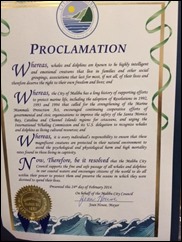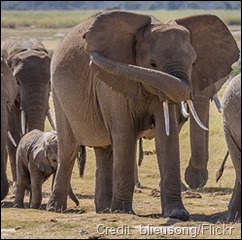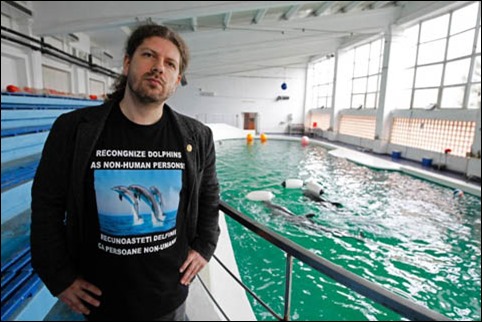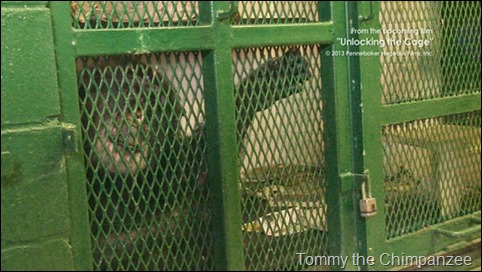 Since the Nonhuman Rights Project filed its first series of lawsuits in December, there have been several other initiatives to secure legal rights for nonhuman animals.
Since the Nonhuman Rights Project filed its first series of lawsuits in December, there have been several other initiatives to secure legal rights for nonhuman animals.
Last week, for example, the mayor of Malibu signed a proclamation endorsing the right of cetaceans to bodily liberty, saying that:
“… Whereas, whales and dolphins are known to be highly intelligent and emotional creatures… and therefore deserve the right to their own freedom and lives.
“… Therefore, be it resolved that the Malibu City Council supports the free and safe passage of all whales and dolphins in our coastal waters, and encourages citizens of the world to do all within their power to protect them and preserve the oceans in which they were destined to spend their lives.”
In January, Remus Cernea, a member of the Romanian Parliament, introduced a bill that would recognize dolphins as “nonhuman persons” with specific legal rights. If passed into law, the bill would ban the use of dolphins in live entertainment shows, and people who kill them would be treated as if they had murdered humans.
It’s an election year in Romania, and Cernea’s fellow Members of Parliament have many other issues on their mind, so the bill is unlikely to garner many votes. “At this moment, I have no support,” Cernea told Reuters. But his efforts made news all around the world.
So did the efforts of a group of attorneys in Argentina, who went to court on behalf of Arturo, a 28-year-old polar bear at the Mendoza Zoo. In 2012, his companion, Pelusa, who had been shipped over from Germany died, and Arturo been visibly depressed ever since. Neither does the fact that Argentina is in the middle of another sweltering summer make his life any easier.
They will argue that Arturo has been illegally deprived of his liberty by the zoo and should be immediately relocated.
Canada’s Assiniboine Park Zoo offered to take Arturo, and even to pay for his travel. But the Mendoza Zoo argued that he’s so used to the heat that he would not be able to handle either the travel or the winters of Winnipeg.
So the attorneys filed suit, asking an appellate court to grant them permission to appeal the decision. They will argue to the Criminal Chamber of Mendoza that Arturo has been illegally deprived of his liberty by the zoo and should be immediately relocated – in this case to the Assiniboine Park Zoo.
Initiatives like these may not change the way courts and legislatures view nonhuman animals. But the proverbial elephant in the (court)room is the Nonhuman Rights Project (NhRP), which, on January 10th of this year, filed Notices of Appeal in the cases of Tommy, Kiko, and Hercules and Leo.
In December, the NhRP went to court in New York State on behalf of four chimpanzees, seeking to have them freed from imprisonment in private homes and laboratories so they could be sent to sanctuaries. The habeas corpus suits argued that the chimpanzees should be recognized as “legal persons” with the fundamental right to bodily liberty, based on their level of complex cognition, self-awareness and autonomy, rather than simply pieces of property that can be owned, imprisoned and used for experiments.
All three lower court judges denied the petitions, which was not unexpected, since expanding the common law is typically left up to the higher courts. But two of the judges made it clear that they supported the initiative – one of them wishing the attorneys “good luck with your venture,” and the other saying that he just did not want to be the first “to make that leap of faith.” The Nonhuman Rights Project is preparing its next series of cases – most likely on behalf of chimpanzees or elephants.
Each of the three lawsuits involves a separate appeal, since the chimpanzees are imprisoned in three different judicial departments. So there will be three separate rulings that may, or may not, even agree. It will also be several months before the appellate departments hear the appeals. And if any or all of the courts don’t feel ready to extend legal personhood to chimpanzees, the cases can be appealed to New York’s highest court, the Court of Appeals.
The NhRP is also preparing its next series of cases – most likely on behalf of chimpanzees or elephants in another state.
 Over the last three months, since the NhRP filed its first suits in December, the topic of legal rights for nonhuman animals has been in the news almost every week. SeaWorld finds itself under a continuing stream of criticism for holding dolphins and whales in captivity. Last week, once again, the marine circus found itself on the defensive when a nine-year-old girl was bitten by a frustrated dolphin. (Once again, they blamed the girl!)
Over the last three months, since the NhRP filed its first suits in December, the topic of legal rights for nonhuman animals has been in the news almost every week. SeaWorld finds itself under a continuing stream of criticism for holding dolphins and whales in captivity. Last week, once again, the marine circus found itself on the defensive when a nine-year-old girl was bitten by a frustrated dolphin. (Once again, they blamed the girl!)
 Meanwhile, evidence continues to mount in terms of the cognitive abilities of great apes, dolphins and other cetaceans, and, in a most recent study, elephants.
Meanwhile, evidence continues to mount in terms of the cognitive abilities of great apes, dolphins and other cetaceans, and, in a most recent study, elephants.
In Thailand Dr. Joshua Plotnik studied 26 elephants at a wildlife park, and concluded that their behavior in relation to each other demonstrated clear evidence of empathy. When, for example, one elephant was disturbed others in her group would gather around, making chirping sounds and touched her all over in what scientists see as a form or reassurance.
With initiatives sprouting in this country and all over the world, the legal wall that separates all humans from all other animals is finally beginning to crack. Sooner or later it will be breached.




